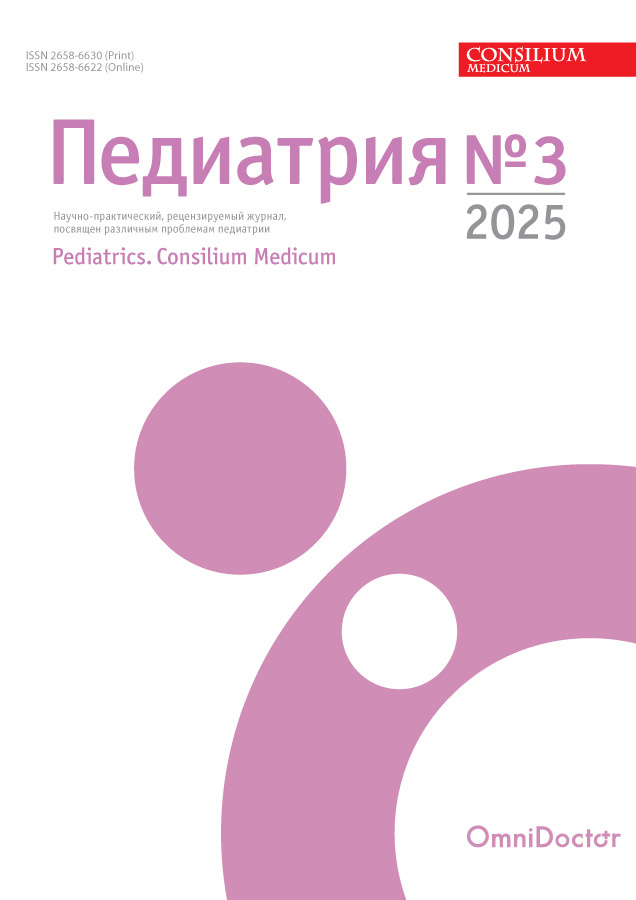Forewarned is forearmed: extravasation as a risk in pediatric infusion therapy. A literature review and clinical cases
- 作者: Oborkina D.S.1,2, Budkevich L.I.1,2, Soshkina V.V.2, Mirzoyan G.V.2, Astamirova T.S.2
-
隶属关系:
- Pirogov Russian National Research Medical University
- Speransky Children's City Clinical Hospital №9
- 期: 编号 3 (2025)
- 页面: 202-207
- 栏目: Articles
- URL: https://pediatria.orscience.ru/2658-6630/article/view/690032
- DOI: https://doi.org/10.26442/26586630.2025.3.203419
- ID: 690032
如何引用文章
全文:
详细
Extravasation is the unintentional entry of drugs into the intervascular space. Depending on the substance, it can lead to tissue necrosis associated with certain complications. Extravasation is reported in up to 46% of children, especially newborns; soft tissue necrosis develops in 4% of those affected, leading to the formation of cicatricial contractures, deformities, and subsequent restriction, and in some cases even to loss of limb function. Currently, there are no guidelines for the management of extravasation injuries in children. In our paper, we highlighted the latest literature using PubMed and Google Scholar resources, as well as our own clinical experience in providing care to patients with adverse events as a result of extravasation. The lack of randomized controlled trials for the treatment of children with extravasation complications and the reluctance of health professionals to report this condition in the medical records alter the evidence-based statistics. Depending on the substance, the volume of fluid injected, and the extent of damage to the surrounding tissues, treatment options can be varied, including surgical and non-surgical methods. Non-surgical therapies include the injections of antidotes, hyaluronidase, or vasodilators, and the procedures for draining and lavage of the lesion. Each clinical case requires an individualized approach, and the care provided should be both sufficient and timely to reduce the frequency of severe complications with disabling outcomes.
全文:
作者简介
Daria Oborkina
Pirogov Russian National Research Medical University; Speransky Children's City Clinical Hospital №9
编辑信件的主要联系方式.
Email: daria100199@gmail.com
ORCID iD: 0000-0001-5021-9594
Res. Assist.
俄罗斯联邦, Moscow; MoscowLiudmila Budkevich
Pirogov Russian National Research Medical University; Speransky Children's City Clinical Hospital №9
Email: daria100199@gmail.com
ORCID iD: 0000-0002-8975-6108
D. Sci. (Med.), Prof.
俄罗斯联邦, Moscow; MoscowVera Soshkina
Speransky Children's City Clinical Hospital №9
Email: daria100199@gmail.com
ORCID iD: 0000-0002-8605-8670
Cand. Sci. (Med.)
俄罗斯联邦, MoscowGayane Mirzoyan
Speransky Children's City Clinical Hospital №9
Email: daria100199@gmail.com
ORCID iD: 0009-0005-2229-215X
Pediatric Surgeon
俄罗斯联邦, MoscowTatyana Astamirova
Speransky Children's City Clinical Hospital №9
Email: daria100199@gmail.com
Pediatric Surgeon
俄罗斯联邦, Moscow参考
- Murphy AD, Gilmour RF, Coombs CJ. Extravasation injury in a paediatric population. ANZ J Surg. 2019;89(4):E122-6.
- Hackenberg RK, Kabir K, Müller A, et al. Extravasation Injuries of the Limbs in Neonates and Children – Development of a Treatment Algorithm. Dtsch Arztebl Int. 2021;118(33-4):547-54.
- Atay S, Sen S, Cukurlu D. Incidence of infiltration/extravasation in newborns using peripheral venous catheter and affecting factors. Rev Esc Enferm USP. 2018;52.
- Khan MS, Holmes JD. Reducing the morbidity from extravasation injuries. Ann Plast Surg. 2002;48:628-32.
- The Royal Children's Hospital Melbourne (2022) Peripheral extravasation injuries: Initial management and washout procedure. Available at: https://www.rch.org.au/clinicalguide/guideline_index/Peripheral_extravasation_injuries__Initial_management_and_washout_procedure/ Accessed: 28.04.2025.
- Millam DA. Managing complications of iv . therapy (continuing education credit). Nursing. 1988;18:34-43.
- Simona R. A pediatric peripheral intravenous infiltration assessment tool. J Infus Nurs. 2012;35:243-8.
- Leitlinienprogramm Onkologie (Deutsche Krebsgesellschaft, Deutsche Krebshilfe, AWMF) S3-Leitlinie „Supportive Therapie bei onkologischen PatientInnen – Langversion 1.3“. AWMF-Register-Nummer: 032/054OL. Available at: www.leitlinienprogramm-onkologie.de/fileadmin/user_upload/Downloads/Leitlinien/Supportivtherapie/LL_Supportiv_Langversion_1.3.pdf. Accessed: 20.04.2025.
- Kim JT, Park JY, Lee HJ, Cheon YJ. Guidelines for the management of extravasation. J Educ Eval Health Prof. 2020;17:21.
- Perez Fidalgo JA, Garcia Fabregat L, Cervantes A, et al. Management of chemotherapy extravasation: ESMO-EONS clinical practice guidelines. Ann Oncol. 2012;23:vii167-73.
- Denkler KA, Cohen BE. Reversal of dopamine extravasation injury with topical nitroglycerin ointment. Plast Reconstr Surg. 1989;84:811-3.
- Wong AF, McCulloch LM, Sola A. Treatment of peripheral tissue ischemia with topical nitroglycerin ointment in neonates. J Pediatr. 1992;121:980-3.
- Siwy BK, Sadove AM. Acute management of dopamine infiltration injury with Regitine. Plast Reconstr Surg. 1987;80:610-2.
- Thigpen JL. Peripheral intravenous extravasation: nursing procedure for initial treatment. Neonatal Netw. 2007;26:379-84.
- Yan YM, Fan QL, Li AQ, et al. Treatment of cutaneous injuries of neonates induced by drug extravasation with hyaluronidase and hirudoid. Iran J Pediatr. 2014;24:352-8.
- Hanrahan K. Hyaluronidase for treatment of intravenous extravasations: implementation of an evidence-based guideline in a pediatric population. J Spec Pediatr Nurs. 2013;18:253-62.
- Chandavasu O, Garrow E, Valda V, et al. A new method for the prevention of skin sloughs and necrosis secondary to intravenous infiltration. Am J Perinatol. 1986;3:4-5.
补充文件















